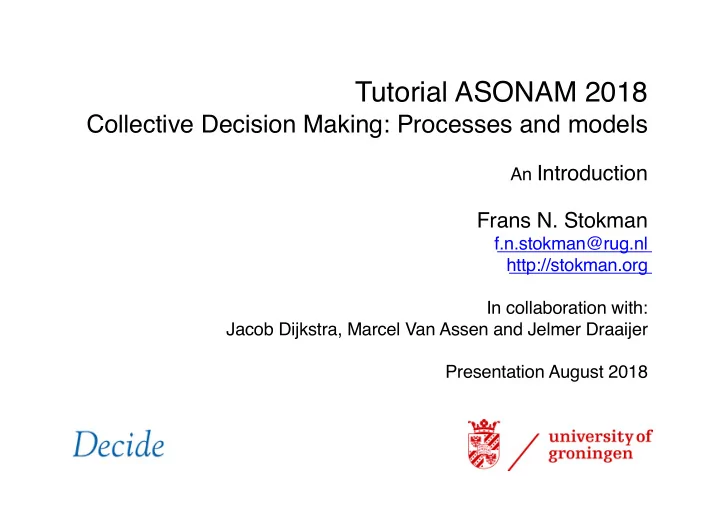

Tutorial ASONAM 2018 Collective Decision Making: Processes and models An Introduction Frans N. Stokman f.n.stokman@rug.nl http://stokman.org In collaboration with: Jacob Dijkstra, Marcel Van Assen and Jelmer Draaijer Presentation August 2018
Collective decision Making § Two stages (Mokken and Stokman 1976; Stokman and Van den Bos 1992): § first stage: influence aimed at building a sufficiently large coalition close to own policy position § second stage: voting based on voting positions , partly adapted during influence stage § Influence in first phase determined by resources plus access § Power in second phase determined by voting power
Instrumental and higher ordered goals Utility salience Instrumental O d policy position x Ad Goal (e.g. ecotax) Utility Ultimate goal (e.g. economic growth) Ultimate goal (e.g. pollution)
Bargaining Processes Three fundamental bargaining processes, resulting in position changes and coalition building • Persuasion – Convincing information oriented towards cooperative solutions for all stakeholders – ( information and trust networks dominant) • Exchange – Cooperative bilateral deals oriented towards profitable solutions for both partners (possibly with negative externalities for others) – ( exchange networks dominant) • Enforcement – ( power networks dominant)
Fundamental Dominant Networks Integrated Approach Conditions for process Processes to dominate Persuasion Information Networks Cooperative 1.Reversal point very Nash Bargaining unattractive Solution for all relevant 2.Overall coalition actors possible/sub coalitions difficult to form 3.Risk averse actors Logrolling Negotiated Exchange Voting position Opposite positions and Networks exchange model complementary interests (Cooperative solutions for subsets of actors with positive and/or negative externalities for others) Enforcement Hierarchical/ Power (Non-cooperative) Opposite positions and Networks Challenge model non-complementary interests
Nash Bargaining Solution for all actors involved If: • Reversal point is very undesirable (very high costs of no agreement) • The grand coalition is possible but firm coalitions among subsets are difficult to construct • The loss function is quadratic around policy position An approximation of the Nash Bargaining Solution (NBS) is: n å c s x id id id = = i 1 O d n å c s id id = i 1 Christopher H. Achen, Institutional realism and bargaining models. In Robert Thomson et al. The European Union Decides, Cambridge: Cambridge University Press 2006, Pp. 86-123
Exchanging Voting Positions Issue 1 A C B D O1 (NBS as expected outcome) Issue 2 D A C B O2
Voting Position Exchange Possibilities Issue 2 Left Right Left A B Issue 1 Right C D
Exchange rates: Equal gain • Equal gain – Assumes cardinal utility, invariant for affine transformations, quod non – Advantage: potential exchanges can be ordered and executed on the basis of utility gain for both exchange partners – Small variations in collective outcomes in case two potential exchanges generate the same utility gains for the exchange partners – No estimates of confident intervals for voting positions and outcomes Stokman, Frans N., and Reinier Van Oosten, 1994 The Exchange of Voting Positions: An Object-Oriented Model of Policy Networks, Bruce Bueno de Mesquita and Frans N. Stokman (eds), European Community Decision Making: Models, Applications, and Comparisons , New Haven: Yale University Press, 105-127
Random variation of gains: example (1) Pareto frontier (PF) of utilities Upper portion: B shifts all the way to A Lower portion: A shifts all the way to B (nonrandom) Equal Gain: 32 for both
Random variation of gains: example (2) Random draw from 4 line segments: 1. Y-axis, above EG (below red bar) 2. Y-axis, below EG (above red bar) 3. X-axis, left of EG (right of red bar) 4. X-axis, right of EG (left of red bar) Choice of p determines width of interval
Random variation of gains: example (3) Actor A is randomly selected to win Actor A is randomly chosen (blue line segment, above EG) (y-axis in bold face)
Random variation of gains: example (4) Utility interval for A shown by red line segment (bounded above by p )
Random variation of gains: example (5) Random utility for A is 60, implying utility of 25 for B Jacob Dijkstra, Marcel Van Assen, Frans Stokman and Jelmer Draaijer Random Variation of Exchange Rates in the Equal Utility Exchange Model (Internal paper 2018)
Enforcement, based on voting rights and/or other power differences Do not challenge Challenge existing policy existing policy No change in Opponent Opponent does policy gives in not give in Policy improves Policy Challenger Challenger worsens wins loses
Copenhagen Study • Through interviews with two experts of Stockholm Environment Institute: – Determination of most controversial issues – Groups of COP Parties – Positions on and Salience for outcome close to own position for all COP Party Groups on all issues – Relative influence and salience for overall consensus • Computer simulation for analysis of dynamic decision making process and optimal strategy http://stokman.org/artikel/15Stok.WasCopenhagenClimateTreatyPossible.pdf
17
19
Expected outcomes based on NBS and Agreement Indicator
Expected outcomes after realization of bilateral exchanges between Party Groups, and Agreement Indicator 21
COP Paris 2015 Outcome Predictions
COP Paris 2015 mean errors http://stokman.org/artikel/16%20Sprinz%20et%20al%20Politics&Governance.pdf
Analysis COPs Copenhagen-Paris • Copenhagen 2009 COP15 – Blockade by two central issues: Kyoto Treaty and MRV by particularly China and India – Enforcement (power) dominant • Paris December 2015 COP21 – Carefully prepared with 5 COP’s between COP15 and COP21 – Persuasion dominant thanks to new studies on climate change, supported by almost all climatologists – Joint production dominant thanks to concrete ambitious goals 2050 and 2100 – Joint production in implementation crucial as Enforcement is limited (‘should comply’ instead of ‘shall comply’)
Next • Jelmer Draaijer: software for equal gain and random exchange rates models • Lars Padmos: process of collecting data • Exercise: compare equal gain with random rates on one of the datasets (potential coalitions; one of the Paris restricted subsets)
Recommend
More recommend